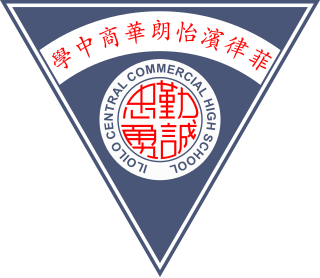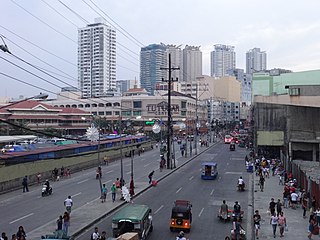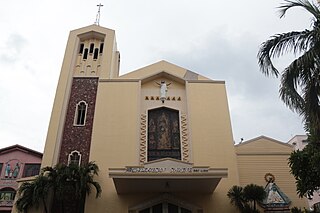
Sampaloc is a district of Manila, Philippines. It is referred to as the University Belt or simply called "U-Belt" for numerous colleges and universities are found within the district such as the University of Santo Tomas, the oldest extant university in Asia; the National University, the first private nonsectarian and coeducational institution in the Philippines; the Far Eastern University, known for its Art Deco campus and cultural heritage site of the Philippines; and the University of the East, once dubbed as the largest university in Asia in terms of enrollment. The district is bordered by the districts of Quiapo and San Miguel in the south, Santa Mesa district in the south and east, Santa Cruz district in the west and north, and Quezon City in the northeast.

San Miguel is a primarily middle-class residential area of the City of Manila and is one of the city's sixteen traditional districts.

Santa Mesa is a district in Manila, Philippines. It is surrounded by the Pasig River on the southwestern side, and by the San Juan River on its southern and eastern side. Land borders include the districts of San Miguel to the west and Sampaloc to the north; and to the northeast is Quezon City.

The University of the East, also known as UE, is a private university located in Manila, Philippines. Founded in 1946, business tycoon Lucio Tan acquired the university in 1990. UE was once labeled as the "largest university in Asia" when its enrollment in the past reached over 65,000 students.

The National University (NU), colloquially National U, is a private non–sectarian coeducational university located in Sampaloc, Manila, Philippines. The founder of the university, Mariano F. Jhocson Sr., established the institution on August 1, 1900, as Colegio Filipino in Quiapo, Manila. It is considered as the first private nonsectarian and coeducational institution in the Philippines and also, the first university to use English as its medium of instruction, replacing Spanish.

The University of Manila, is a private, non-sectarian coeducational basic and higher education institution in the heart of Sampaloc District in Manila, Philippines. It was founded on October 5, 1913 as the Instituto de Manila, by Apolinario G. de los Santos, Mariano V. de los Santos, Maria de los Santos, Buenaventura J. Bello and Antonio Rivero. The first three were siblings. They named their school Instituto de Manila, after the city of Manila and Apolinario G. de los Santos was elected as the first director of the school.

Santa Cruz is a district in the northern part of the City of Manila, Philippines, located on the right bank of the Pasig River near its mouth, bordered by the districts of Tondo, Binondo, Quiapo, and Sampaloc, as well as the areas of Grace Park and Barrio San Jose in Caloocan and the district of La Loma in Quezon City. The district belongs to the 3rd congressional district of Manila.

Arellano University (AU) is a private, coeducational, nonsectarian university located in Manila, the Philippines. It was founded in 1938 as a law school by Florentino Cayco Sr., the first Filipino Undersecretary of Public Instruction. The university was named after Cayetano Arellano, the first Chief Justice of the Supreme Court of the Philippines. It operates seven campuses located throughout Metro Manila and the main campus is located along Legarda Street, Sampaloc, Manila. The Arellano University School of Law is autonomous and managed by the Arellano Law Foundation. Its athletic team, the Arellano University Chiefs, is a member of the National Collegiate Athletic Association since 2009.

The University Belt is the name of a de facto subdistrict in Manila, Philippines, referring to an area that has a significant concentration of major colleges and universities in the city. The districts of Quiapo, Sampaloc, and San Miguel are traditionally considered to be the University Belt, although other clusters of schools that lie along the southern bank of the Pasig River, mostly at the districts of Intramuros and Ermita, as well as the southernmost part of Malate near the city limits are also sometimes included. Each of the colleges and universities found in the district are a short walking distance of each other.

Philippine Cultural College is a Chinese Filipino school with three campuses located in Manila, Caloocan and Quezon City, Metro Manila, Philippines, established on June 27, 1923 by the Philippine Chinese Educational Association. PCC is the oldest Chinese Filipino secondary school in the Philippines. It is a non-stock, non-profit, and non-sectarian co-educational education institution offering pre-school, and has a Level II re-accredited status from the Philippine Accrediting Association of Schools, Colleges and Universities (PAASCU) for its grade school and high school. Its programs emphasize in the English, Filipino, and Mandarin Chinese languages, Mathematics, Science, and Information Technology.

The University of Santo Tomas is one of the oldest existing universities and holds the oldest extant university charter in the Philippines and in Asia. It was founded on April 28, 1611, by the third Archbishop of Manila, Miguel de Benavides, together with Frs. Domingo de Nieva and Bernardo de Santa Catalina. It was originally conceived as a school to prepare young men for the priesthood. Located Intramuros, it was first called Colegio de Nuestra Señora del Santísimo Rosario and later renamed Colegio de Santo Tomás in memory of Dominican theologian Saint Thomas Aquinas. In 1624, the Colegio was authorized to confer academic degrees in theology, philosophy and arts. On November 20, 1645, after representations by Vittorio Riccio, Pope Innocent X elevated the college to the rank of a university and in 1680 it was placed under royal patronage.

Hua Siong College of Iloilo or HSCI, commonly referred to as Hua Siong, is a private college located Iloilo City, Philippines. Founded by the Filipino Chinese Chamber of Commerce of Iloilo as a preparatory school in 1912, it is the first Chinese school outside of Manila.

The Philippine School of Business Administration is a college located in Quezon City in Metro Manila, Philippines. The college was established in 1963.

Claro M. Recto Avenue, more popularly known as simply Recto, is the principal commercial thoroughfare in north-central Manila, Philippines. It spans seven districts just north of the Pasig River in what is generally considered Manila's old downtown area.

Lacson Avenue is the principal northwest–southeast artery located in Sampaloc district in northern Manila, Philippines. It is a 6-8 lane median divided avenue that runs approximately 2.9 kilometers (1.8 mi) from Tayuman Street in Santa Cruz to Nagtahan Interchange. It is a component of Circumferential Road 2 of the Manila arterial road network and N140 of the Philippine highway network.

Legarda Street is a short street located in Sampaloc district in Manila, Philippines. It crosses through the eastern section of the University Belt area in a generally east–west orientation between the Nagtahan Interchange and the intersection with Nepomuceno Street in Quiapo. It is served by Legarda station of the LRTA's Line 2 system.

Blumentritt Road is a major road in Manila, Philippines. It runs through the border of the City of Manila with Quezon City from Rizal Avenue in Santa Cruz district to G. Tuazon Street in Sampaloc district. The road also forms the southern boundary of the Manila North Cemetery. It is named after Bohemian professor and filipinologist, Ferdinand Blumentritt.

The San Juan River Bridge, also known as Pinaglabanan Bridge, San Juan del Monte Bridge, San Juan Bridge and the Old Santa Mesa Bridge, is a bridge that connects San Juan and Manila, spanning the San Juan River. The 46.85-meter (153.7 ft) bridge connects the N. Domingo Street in San Juan and Old Santa Mesa Street in Manila. The location of the bridge served as a battlefield during the 1896 Philippine Revolution against the Spaniards and the 1899 Philippine–American War.

Sampaloc Church or the Archdiocesan Shrine of Our Lady of Loreto is a Roman Catholic Church located along Figueras Street in the district of Sampaloc in the City of Manila. The church is named after and dedicated to the Virgin Mary and her pilgrimage site in Loreto, Italy where tradition states as the site where the Mary's house was relocated.

The Rafael Enriquez House, also known as Casa Hidalgo, is a heritage house originally located at Quiapo, Manila, owned by Rafael Enriquez, a Spanish peninsular and painter (1850–1937). The house was built in 1867 – one of the first projects of architect Felix Roxas y Arroyo. Some of his notable works were Paterno House and Zamora House in Quiapo, Manila and the 1867 Santo Domingo Church in Intramuros, Manila. However, a carving on king post, stating "1807", indicates that the house was built before Rafael Enriquez occupied the house. This was discovered in 2006 – wherein the house was dismantled and relocated at Las Casas Filipinas de Acuzar, Bagac, Bataan.





















